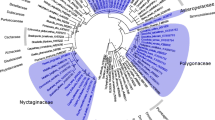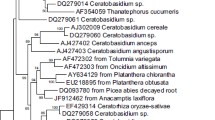Abstract
Plant phylogeny constrains orchid mycorrhizal (OrM) fungal community composition in some orchids. Here, we investigated the structures of the OrM fungal communities of eight Dendrobium species in one niche to determine whether similarities in the OrM fungal communities correlated with the phylogeny of the host plants and whether the Dendrobium-OrM fungal interactions are phylogenetically conserved. A phylogeny based on DNA data was constructed for the eight coexisting Dendrobium species, and the OrM fungal communities were characterized by their roots. There were 31 different fungal lineages associated with the eight Dendrobium species. In total, 82.98% of the identified associations belonging to Tulasnellaceae, and a smaller proportion involved members of the unknown Basidiomycota (9.67%). Community analyses revealed that phylogenetically related Dendrobium tended to interact with a similar set of Tulasnellaceae fungi. The interactions between Dendrobium and Tulasnellaceae fungi were significantly influenced by the phylogenetic relationships among the Dendrobium species. Our results provide evidence that the mycorrhizal specificity in the eight coexisting Dendrobium species was phylogenetically conserved.
Similar content being viewed by others
References
Bailarote, B.C., Lievens, B., and Jacquemyn, H. (2012). Does mycorrhizal specificity affect orchid decline and rarity? Am J Bot 99, 1655–1665.
Baker, M.L.B, and Charles, O. (1996). Orchid Species Culture: Dendrobium. (Portland: Timber Press).
Bidartondo, M.I., Burghardt, B., Gebauer, G., Bruns, T.D., and Read, D.J. (2004). Changing partners in the dark: isotopic and molecular evidence of ectomycorrhizal liaisons between forest orchids and trees. Proc R Soc B 271, 1799–1806.
Blomberg, S.P., Garland, T., and Ives, A.R. (2003). Testing for phylogenetic signal in comparative data: behavioral traits are more labile. Evolution 57, 717–745.
Bonnet, E., and Van de Peer, Y. (2002). ZT: a software tool for simple and partial Mantel tests. J Stat Softw 7: 1–12.
Brundrett, M.C. (2007). Scientific approaches to Australian temperate terrestrial orchid conservation. Aust J Bot 55, 293.
Cameron, K.M. (2005). Leave it to the leaves: a molecular phylogenetic study of Malaxideae (Epidendroideae, Orchidaceae). Am J Bot 92, 1025–1032.
Darriba, D., Taboada, G.L., Doallo, R., and Posada, D. (2012). jModelTest 2: more models, new heuristics and parallel computing. Nat Methods 9: 772.
Dearnaley, J.D.W. (2007). Further advances in orchid mycorrhizal research. Mycorrhiza 17, 475–486.
Dearnaley, J.D.W., Martos, F., and Selosse, M.A. (2012). Orchid mycorrhizas: molecular ecology, physiology, evolution and conservation aspects. In: Fungal Association, 2nd ed. B, Hock. (Berlin: Springer-Verlag), pp. 207–230.
Drummond, A.J., Ho, S.Y.W., Phillips, M.J., and Rambaut, A. (2006). Relaxed phylogenetics and dating with confidence. PLoS Biol 4, e88.
Drummond, A.J., and Rambaut, A. (2007). BEAST: Bayesian evolutionary analysis by sampling trees. BMC Evol Biol 7, 214.
Edgar, R.C. (2013). UPARSE: highly accurate OTU sequences from microbial amplicon reads. Nat Meth 10, 996–998.
Fu, L.K. (1992). China Plant Red Data Book: Rare and Endangered Plants. (Beijing: Science Press).
Gilbert, G.S., and Webb, C.O. (2007). Phylogenetic signal in plant pathogenhost range. Proc Natl Acad Sci USA 104, 4979–4983.
Ives, A.R., and Godfray, H.C.J. (2006). Phylogenetic analysis of trophic associations. Am Natist 168, E1–E14.
Jacquemyn, H., Brys, R., Merckx, V.S.F.T., Waud, M., Lievens, B., and Wiegand, T. (2014). Coexisting orchid species have distinct mycorrhizal communities and display strong spatial segregation. New Phytol 202, 616–627.
Jacquemyn, H., Brys, R., Waud, M., Busschaert, P., and Lievens, B. (2015). Mycorrhizal networks and coexistence in species-rich orchid communities. New Phytol 206, 1127–1134.
Jacquemyn, H., Honnay, O., Cammue, B.P.A., Brys, R., and Lievens, B. (2010). Low specificity and nested subset structure characterize mycorrhizal associations in five closely related species of the genus Orchis. Mol Ecol 19, 4086–4095.
Jacquemyn, H., Merckx, V., Brys, R., Tyteca, D., Cammue, B.P.A., Honnay, O., and Lievens, B. (2011). Analysis of network architecture reveals phylogenetic constraints on mycorrhizal specificity in the genus Orchis (Orchidaceae). New Phytol 192, 518–528.
Jacquemyn, H., Brys, R., Lievens, B., and Wiegand, T. (2012). Spatial variation in below-ground seed germination and divergent mycorrhizal associations correlate with spatial segregation of three co-occurring orchid species. J Ecol 100, 1328–1337.
Kembel, S.W., Cowan, P.D., Helmus, M.R., Cornwell, W.K., Morlon, H., Ackerly, D.D., Blomberg, S.P., and Webb, C.O. (2010). Picante: R tools for integrating phylogenies and ecology. Bioinformatics 26, 1463–1464.
Larkin, M.A., Blackshields, G., Brown, N.P., Chenna, R., McGettigan, P.A., McWilliam, H., Valentin, F., Wallace, I.M., Wilm, A., Lopez, R., Thompson, J.D., Gibson, T.J., and Higgins, D.G. (2007). Clustal W and Clustal X version 2.0. Bioinformatics 23, 2947–2948.
Losos, J.B. (2008). Phylogenetic niche conservatism, phylogenetic signal and the relationship between phylogenetic relatedness and ecological similarity among species. Ecol Lett 11: 995–1007.
Martos, F., Munoz, F., Pailler, T., Kottke, I., Gonneau, C., and Selosse, M.A. (2012). The role of epiphytism in architecture and evolutionary constraint within mycorrhizal networks of tropical orchids. Mol Ecol 21, 5098–5109.
McCormick, M.K., and Jacquemyn, H. (2014). What constrains the distribution of orchid populations? New Phytol 202, 392–400.
McCormick, M.K., Whigham, D.F., and O’Neill, J. (2004). Mycorrhizal diversity in photosynthetic terrestrial orchids. New Phytol 163, 425–438.
McCune, B., and Mefford, M.J. (2011). PC-ORD. Multivariate analysis of ecological data. Version 6. Gleneden Beach (USA): MjM Software Design.
Poulin, R. (2010). Decay of similarity with host phylogenetic distance in parasite faunas. Parasitology 137, 733.
Rasmussen, H.N., and Rasmussen, F.N. (2009). Orchid mycorrhiza: implications of a mycophagous life style. Oikos 118, 334–345.
Rasmussen, H.N. (1995). Terrestrial Orchids: From Seed to Mycotrophic Plant. (Cambridge: Cambridge University Press).
Rasmussen, H.N. (2002). Recent developments in the study of orchid mycorrhiza. Plant Soil 244, 149–163.
Rasmussen, H.N., Dixon, K.W., Jersáková, J., and Tešitelová, T. (2015). Germination and seedling establishment in orchids: a complex of requirements. Ann Bot 116, 391–402.
Reinhart, K.O., and Anacker, B.L. (2014). More closely related plants have more distinct mycorrhizal communities. AoB Plants 6, plu051–plu051.
Reinhart, K.O., Wilson, G.W.T., and Rinella, M.J. (2012). Predicting plant responses to mycorrhizae: integrating evolutionary history and plant traits. Ecol Lett 15, 689–695.
Rezende, E.L., Lavabre, J.E., Guimarães, P.R., Jordano, P., and Bascompte, J. (2007). Non-random coextinctions in phylogenetically structured mutualistic networks. Nature 448, 925–928.
Shefferson, R.P., Cowden, C.C., McCormick, M.K., Yukawa, T., Ogura-Tsujita, Y., and Hashimoto, T. (2010). Evolution of host breadth in broad interactions: mycorrhizal specificity in East Asian and North American rattlesnake plantains (Goodyera spp.) and their fungal hosts. Mol Ecol 19, 3008–3017.
Shefferson, R.P., Kull, T., and Tali, K. (2008). Mycorrhizal interactions of orchids colonizing Estonian mine tailings hills. Am J Bot 95, 156–164.
Shefferson, R.P., Taylor, D.L., Weiss, M., Garnica, S., McCormick, M.K., Adams, S., Gray, H.M., McFarland, J.W., Kull, T., Tali, K., Yukawa, T., Kawahara, T., Miyoshi, K., and Lee, Y.I. (2007). The evolutionary history of mycorrhizal specificity among lady’s slipper orchids. Evolution 61, 1380–1390.
Smith, S.E., and Read, D.J. (2008). Mycorrhizal Symbiosis. 3rd ed. (London: Academic Press).
Stamatakis, A., Hoover, P., and Rougemont, J. (2008). A rapid bootstrap algorithm for the RAxML web servers. Syst Biol 57, 758–771.
Swarts, N.D., and Dixon, K.W. (2009). Perspectives on orchid conservation in botanic gardens. Trends Plant Sci 14, 590–598.
Tamura, K., Peterson, D., Peterson, N., Stecher, G., Nei, M., and Kumar, S. (2011). MEGA5: molecular evolutionary genetics analysis using maximum likelihood, evolutionary distance, and maximum parsimony methods. Mol Biol Evol 28, 2731–2739.
Taylor, D.L., and McCormick, M.K. (2008). Internal transcribed spacer primers and sequences for improved characterization of basidiomycetous orchid mycorrhizas. New Phytol 177, 1020–1033.
Tedersoo, L., Mett, M., Ishida, T.A., and Bahram, M. (2013). Phylogenetic relationships among host plants explain differences in fungal species richness and community composition in ectomycorrhizal symbiosis. New Phytol 199, 822–831.
Tupac Otero, J., Ackerman, J.D., and Bayman, P. (2002). Diversity and host specificity of endophytic Rhizoctonia-like fungi from tropical orchids. Am J Bot 89, 1852–1858.
Veresoglou, S.D., and Rillig, M.C. (2014). Do closely related plants host similar arbuscular mycorrhizal fungal communities? A meta-analysis. Plant Soil 377, 395–406.
Wang, B., and Qiu, Y.L. (2006). Phylogenetic distribution and evolution of mycorrhizas in land plants. Mycorrhiza 16, 299–363.
Waud, M., Wiegand, T., Brys, R., Lievens, B., and Jacquemyn, H. (2016). Nonrandom seedling establishment corresponds with distance-dependent decline in mycorrhizal abundance in two terrestrial orchids. New Phytol 211, 255–264.
Weiblen, G.D., Webb, C.O., Novotny, V., Basset, Y., and Miller, S.E. (2006). Phylogenetic dispersion of host use in a tropical insect herbivore community. Ecology 87: S62–S75.
White, T.J., Bruns, T.D., Lee, S.B., and Taylor, J.W. (1990). Amplification and direct sequencing of fungal ribosomal RNA genes for phylogenetics. In PCR Protocols: A Guide to Methods and Applications, M.A. Innis, D.H. Gelfand, J.J. Sninsky, T.J. White, eds. (San Diego: Academic).
Wiens, J.J., Ackerly, D.D., Allen, A.P., Anacker, B.L., Buckley, L.B., Cornell, H.V., Damschen, E.I., Jonathan Davies, T., Grytnes, J.A., Harrison, S.P., Hawkins, B.A., Holt, R.D., McCain, C.M., and Stephens, P.R. (2010). Niche conservatism as an emerging principle in ecology and conservation biology. Ecol Lett 13, 1310–1324.
Xing, X., Gai, X., Liu, Q., Hart, M.M., and Guo, S. (2015). Mycorrhizal fungal diversity and community composition in a lithophytic and epiphytic orchid. Mycorrhiza 25, 289–296.
Xing, X., Ma, X., Deng, Z., Chen, J., Wu, F., and Guo, S. (2013). Specificity and preference of mycorrhizal associations in two species of the genus Dendrobium (Orchidaceae). Mycorrhiza 23, 317–324.
Acknowledgements
We thank Dr. Qiang Liu from Xishuangbanna Tropical Botanical Garden, Chinese Academy of Science and Dr. Yu Zhang from Beijing Botanical Garden for their kind help in sample collection. This work was supported by the National Natural Sciences Foundation of China (81274197).
Author information
Authors and Affiliations
Corresponding authors
Electronic supplementary material
Rights and permissions
About this article
Cite this article
Xing, X., Ma, X., Men, J. et al. Phylogenetic constrains on mycorrhizal specificity in eight Dendrobium (Orchidaceae) species. Sci. China Life Sci. 60, 536–544 (2017). https://doi.org/10.1007/s11427-017-9020-1
Received:
Accepted:
Published:
Issue Date:
DOI: https://doi.org/10.1007/s11427-017-9020-1




